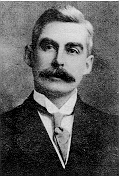

In his 1931 book The New Newfoundland St. John's journalist and labour leader Joseph Smallwood described local businessman William Mackay as "one of Newfoundland's real live-wire businessmen." As the Evening Telegram earlier observed in November 1924, Mackay was a visionary whose "firm belief in the future of his native country is the motive which inspires him in his undertakings". What little is known of this pioneering engineer and businessman indicates that Mackay devoted considerable time and energy to promoting Newfoundland and its avowed abundant natural resources to local and foreign capitalists.
Mackay was born in St. John's on 17 November 1873 and was the son of Alexander and Elizabeth O'Neill Mackay. After receiving his early education in Pictou, Nova Scotia his father's home town William Mackay in 1889 went to work in St. John's as a messenger for the Anglo-American Telegraph Company whose Newfoundland manager was his father.
In the early 1890s William Mackay then worked as an electrical contractor in New York and later returned to Newfoundland by the mid-1890s to undertake similar work there. He also did contracting work on the French Islands of St. Pierre and Miquelon off Newfoundland's south coast; in 1897, for instance, he supervised the installation of a tepehone and electric plant at St. Pierre. In 1898 he was appointed superintendent of the electrical department for the St. John's Street Railway Company owned by Canadian railway builder Robert Reid. Between 1899 and 1900 he was involved in the construction at Petty Harbour of a hydro station and in the building of a street railway system in St. John's.
On 9 February 1901 he married Amy Finella Blacklaw of Scotland and later in July of that year moved to Nova Scotia settling initially in Sydney where he worked for a local electrical utility. The following year he and his brother, Gower, established the electrical contracting firm of W.A. Mackay & Company which did contracting work throughout the Canadian Maritimes and Newfoundland. In 1904 the two brothers established the Sydney Mines Electric Company which constructed and installed an electric lighting station in the town of Sydney Mines. The necessary capital for this plant came from Newfoundland businessman John Joseph Murphy, with whom William Mackay had struck up a close business relationship. In 1904 Mackay's company constructed and installed a hydro-electric plant at Victoria, Newfoundland, for Murphy and his associates in the United Towns Electrical Company. After 1904 he continued to do occasional contracting work in Newfoundland, including the electrical rewiring in 1910 of the Gazette Building in St. John's which had been renovated by the Bank of Montreal.
About 1906 William and Gower Mackay entered the coal mining business in North Sydney as the Mackay Mining Company (known later as the Colonial Coal Company Limited). In 1913 and 1914 William was mayor of North Sydney. Mackay continued to retain an interest in business developments in Newfoundland; in 1915 he had formed a company called the Hydro-Electric Smelting Co. Limited to work an abandoned copper mine at Little Bay, Notre Dame Bay. Despite efforts over a couple of years to put the mine back into operation, it was not re-activated despite four efforts by Mackay to interest American investors in the project. Mackay was president of the company; other directors included Walter Monroe and Tasker Cook.
By 1920 Mackay had returned to Newfoundland and had become a strong enthusiast and promoter of the island's promising economic future that was best symbolized by Prime Minister Richard Squires' recent successful efforts to have British interests build a second paper mill at Corner Brook. On 24 January 1924 Mackay spoke to the St. John's Rotary Club on the "Possibilities of Newfoundland"; as the Daily News later summarized his speech, Mackay noted that stone from the South Side Hill in St. John's could be made into paving blocks and find a large commercial market in the Caribbean islands. He stressed that Newfoundland had sufficient water power to create secondary manufacturing with its abundant forestry and mineral resources. All that was needed was to entice foreign capital to Newfoundland; to this end, he devoted the remainder of his life.
On occasion, his promotions met with little success despite his best efforts. For example, in 1925 the St. John's press reported of a recent visit by Mackay to New York where he had taken "samples of a local material made up here from local peat which, combined with other ingredients, produced an excellent compound for street paving purposes". Another local product he had taken was a clay found on the bottom of many ponds and lakes on the Avalon Peninsula; this clay Mackay hoped could be used in construction work in the United States and form the basis of a new industry in Newfoundland.
One successful effort on his part was his work with the financially troubled St. John's Gas Light Company. By 1930 he had acquired control of this utility and sold it to a group of New York bankers. The new owners reorganized the company and placed it on a sound financial footing.
From 1924 he organized an annual Mercantile and Industrial Fair at St. John's where local businessmen exhibited both local and imported goods. In 1929 he also promoted a company called the Hotel Company Limited to purchase and operate the Crosbie Hotel in St. John's. His fellow investors included David Baird, James Crawford and Olaf Olsen. Mackay managed the Crosbie Hotel until his death at St. John's on 4 June 1934.